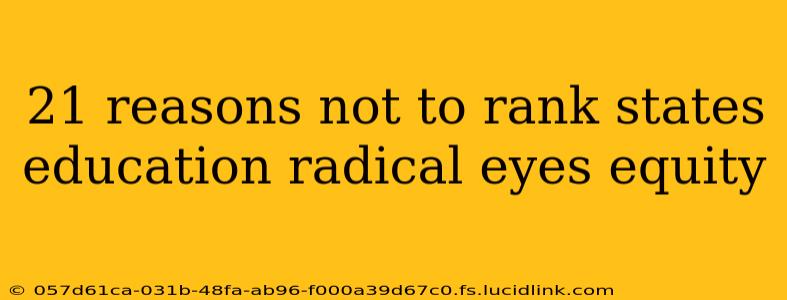21 Reasons Why Ranking States' Education Systems Through a Radical Equity Lens is Problematic
Ranking states' education systems is a complex undertaking, fraught with challenges. While the intention might be to identify areas needing improvement and promote competition, using a "radical equity" lens introduces significant complexities and potential pitfalls. A simplistic ranking system, particularly one focused solely on equity, risks oversimplification and may inadvertently create more problems than it solves. Here are 21 reasons why such a ranking system is problematic:
1. Defining "Radical Equity": The very term "radical equity" is subjective and lacks a universally accepted definition. What constitutes "radical equity" in education will vary depending on individual perspectives and political ideologies, making any ranking inherently biased and potentially contentious.
2. Data Limitations and Inherent Biases: Standardized test scores, often a primary metric in education rankings, are not perfect measures of student learning or equitable outcomes. They are influenced by numerous factors outside of school control, including socioeconomic status, access to resources, and systemic biases.
3. Ignoring Contextual Factors: A ranking system fails to account for the diverse socioeconomic, cultural, and demographic contexts within each state. What constitutes success in one state might be significantly different in another. A wealthy, homogenous state will have different challenges than a state with high levels of poverty and linguistic diversity.
4. Overemphasis on Standardized Testing: Reliance on standardized tests risks narrowing the curriculum and teaching to the test, hindering the development of critical thinking, creativity, and other essential skills.
5. Neglecting Non-Cognitive Factors: Success in education is influenced by factors like grit, resilience, and self-regulation—qualities not easily measured by standardized tests.
6. Lack of Transparency and Methodology: Many ranking systems lack transparency in their methodology, making it difficult to understand how the rankings are derived and what factors are weighted most heavily. This lack of clarity undermines trust and credibility.
7. Perpetuating Harmful Stereotypes: Rankings can inadvertently reinforce negative stereotypes about certain schools, districts, or states, potentially leading to self-fulfilling prophecies and reduced expectations.
8. Ignoring Teacher Quality and Resources: Teacher quality, classroom resources, and school infrastructure significantly influence student outcomes, yet these factors are often inadequately accounted for in rankings.
9. Disincentivizing Collaboration and Innovation: A competitive ranking system can discourage collaboration and knowledge-sharing between states, hindering innovation and improvement.
10. Focusing on Outcomes Over Processes: An overemphasis on outcomes (test scores) overshadows the importance of the educational processes and pedagogical approaches used to achieve them.
11. Difficulty in Measuring "Equity": Defining and measuring equity itself is incredibly challenging. Simple metrics like the achievement gap don't fully capture the complexity of equitable access to opportunity and resources.
12. Ignoring Systemic Inequality: Rankings may not address the underlying systemic issues contributing to inequitable educational outcomes, like housing segregation, unequal access to healthcare, and food insecurity.
13. Political Manipulation of Data: Ranking data can be manipulated or misinterpreted for political purposes, distorting the true picture of educational performance and equity.
14. Ignoring the Needs of Specific Student Populations: Rankings often fail to consider the unique needs of specific student populations, such as students with disabilities, English language learners, and gifted students.
15. Reinforcing Existing Inequalities: A focus on equity through ranking may inadvertently reinforce existing inequalities by highlighting disparities without offering effective solutions.
16. Oversimplification of a Complex Issue: Education is a multifaceted issue, and reducing it to a single ranking score oversimplifies its complexities and nuances.
17. Lack of Actionable Insights: Rankings often fail to provide actionable insights or concrete recommendations for improving educational equity.
18. Creating Unrealistic Expectations: Rankings can set unrealistic expectations for schools and states, leading to demoralization and burnout among educators.
19. Ignoring the Impact on Students: The pressure of rankings can negatively impact students' mental health and well-being, fostering anxiety and competition.
20. Lack of Long-Term Perspective: Rankings often focus on short-term gains rather than long-term improvements in educational systems and equity.
21. Shifting Focus from Holistic Improvement: An overemphasis on rankings distracts from a more holistic approach to improving education that focuses on collaboration, innovation, and student-centered learning.
In conclusion, while the goal of improving educational equity is laudable, relying on a simplistic state-ranking system through a "radical equity" lens is likely to be counterproductive. A more nuanced and comprehensive approach is necessary, focusing on collaborative problem-solving, addressing systemic inequalities, and supporting the development of effective and equitable educational practices.
